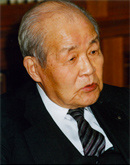

Kenzo Tohata
*11. 4. 1902, Japan
†29. 4. 1998, Japan
Tohata Architects & Engineers
2-3-17 Toranomon, Minato-ku, 105-0001 Tokyo+81 03 3581 1251
+81 03 3581 1257
contact@tohata.co.jp
www.tohata.co.jp
Biography
He became interested in architecture in high school during a visit to the first reinforced concrete building in Kyoto, which was the Faculty of Architecture at Kyoto University, where he enrolled in 1923. After graduating, he became a consultant to the Ministry of Foreign Affairs under the guidance of Professor Goichi Takeda, where he contributed to the design of the Institute of Oriental Culture in Kyoto.
After visiting Europe and America in 1932 at the age of 30, he became independent. In Chicago, he visited an automobile factory designed by Albert Kahn and was impressed by its thorough expression of rationalism. With the support of his father-in-law Katsujiro Iwaie, founder of Iwai Industries, he designed numerous spinning mills not only in Japan but also in China, Taiwan, Korea, and Borneo. The company was constantly growing, but immediately after the end of World War II, there were no design works available, and the company was forced to build private houses. Utilizing the rational methods they had developed so far, they contributed to Japan's post-war reconstruction efforts by supplying panel housing, which is now known as prefabricated construction.
In line with Japan's period of rapid economic growth, the company contributes to society through the design of a wide range of buildings, from industrial buildings, primarily steelworks, to public buildings and urban redevelopment projects. He held public positions including director of the Japan Institute of Architects. As a construction consultant and a member of the site planning committee for the 1970 Expo World Exhibition, he led the first Japanese world expo to great success. In the field of education, he taught for several years at Kyoto University and Osaka University.
He became interested in architecture in high school during a visit to the first reinforced concrete building in Kyoto, which was the Faculty of Architecture at Kyoto University, where he enrolled in 1923. After graduating, he became a consultant to the Ministry of Foreign Affairs under the guidance of Professor Goichi Takeda, where he contributed to the design of the Institute of Oriental Culture in Kyoto.
After visiting Europe and America in 1932 at the age of 30, he became independent. In Chicago, he visited an automobile factory designed by Albert Kahn and was impressed by its thorough expression of rationalism. With the support of his father-in-law Katsujiro Iwaie, founder of Iwai Industries, he designed numerous spinning mills not only in Japan but also in China, Taiwan, Korea, and Borneo. The company was constantly growing, but immediately after the end of World War II, there were no design works available, and the company was forced to build private houses. Utilizing the rational methods they had developed so far, they contributed to Japan's post-war reconstruction efforts by supplying panel housing, which is now known as prefabricated construction.
In line with Japan's period of rapid economic growth, the company contributes to society through the design of a wide range of buildings, from industrial buildings, primarily steelworks, to public buildings and urban redevelopment projects. He held public positions including director of the Japan Institute of Architects. As a construction consultant and a member of the site planning committee for the 1970 Expo World Exhibition, he led the first Japanese world expo to great success. In the field of education, he taught for several years at Kyoto University and Osaka University.
The English translation is powered by AI tool. Switch to Czech to view the original text source.







